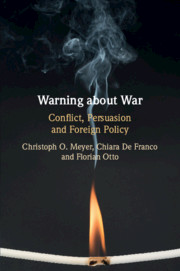Book contents
- Warning about War
- Warning about War
- Copyright page
- Contents
- Figures
- Tables
- Acknowledgements
- Chapter 1 Conflict Warnings as Persuasion Attempts
- Chapter 2 A Theory of Conflict Warning as Persuasion in Foreign Policy
- Chapter 3 Inside-Up Warnings within States and International Organisations
- Chapter 4 Outside-In Warnings
- Chapter 5 Outside-In Warnings
- Chapter 6 (Mis-)identifying Warnings and the Problem of Hindsight Bias
- Chapter 7 What Makes Individual Officials Persuasive Warners?
- Chapter 8 Explaining Differences in Persuasiveness
- Chapter 9 Warning within EU Institutions and the Ukrainian-Russian Conflict of 2013–2014
- Chapter 10 When Are Warnings Heeded and What Can Warners Do?
- References
- Index
Chapter 4 - Outside-In Warnings
Persuasion by NGOs
Published online by Cambridge University Press: 23 August 2019
- Warning about War
- Warning about War
- Copyright page
- Contents
- Figures
- Tables
- Acknowledgements
- Chapter 1 Conflict Warnings as Persuasion Attempts
- Chapter 2 A Theory of Conflict Warning as Persuasion in Foreign Policy
- Chapter 3 Inside-Up Warnings within States and International Organisations
- Chapter 4 Outside-In Warnings
- Chapter 5 Outside-In Warnings
- Chapter 6 (Mis-)identifying Warnings and the Problem of Hindsight Bias
- Chapter 7 What Makes Individual Officials Persuasive Warners?
- Chapter 8 Explaining Differences in Persuasiveness
- Chapter 9 Warning within EU Institutions and the Ukrainian-Russian Conflict of 2013–2014
- Chapter 10 When Are Warnings Heeded and What Can Warners Do?
- References
- Index
Summary
This chapter looks at the persuasion strategies and successes of INGOs. Building on the theoretical framework of Chapter 2, we examine to what extent the most capable INGOs engage in conflict warning (warner capacity), when and how they communicate warnings (communication and message factors) and how they are perceived by key recipients in media and policy-making (credibility and persuasiveness). Our investigation centres on Amnesty International, Human Rights Watch and the International Crisis Group. These INGOs are atypical insofar as they belong to a small group of international ‘advocacy superpowers’. We draw on three sources of data: first, interviews with 154 practitioners from international and local NGOs and think-tanks plus a further 127 interviews with foreign affairs journalists and government/IO officials in the field of conflict prevention; second, a text analysis of the public warning output of these NGOs across six different conflict cases; and third, a recipient survey among analysts and officials active in different organisational contexts, most notably the EU, the United Kingdom and the UN.
Keywords
- Type
- Chapter
- Information
- Warning about WarConflict, Persuasion and Foreign Policy, pp. 90 - 124Publisher: Cambridge University PressPrint publication year: 2019

